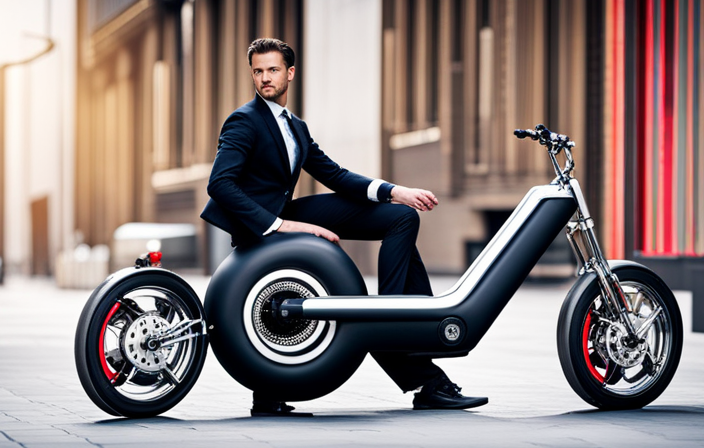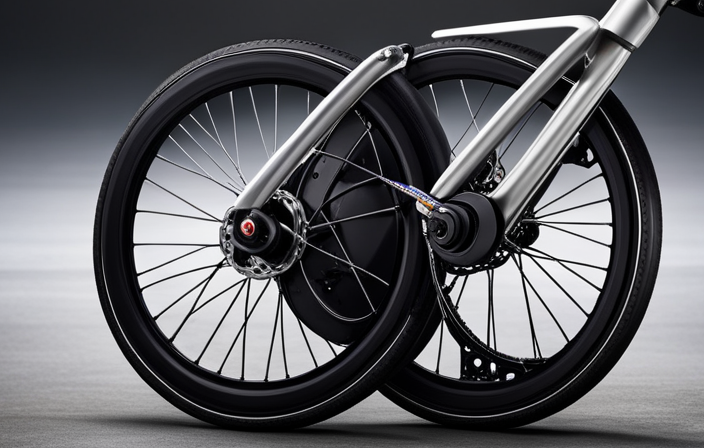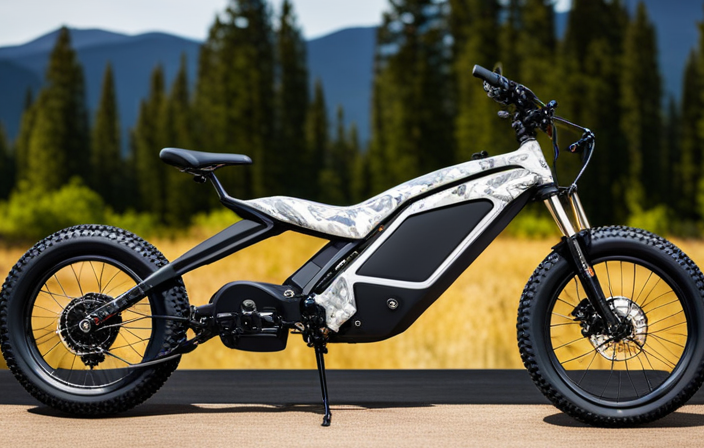As a passionate DIY enthusiast, I have always been intrigued by the realm of electric bikes and the limitless opportunities they present.
But when it comes to choosing the right engine for a DIY electric bike, the options can seem overwhelming. That’s why I’ve compiled this comprehensive guide to help you navigate through the technical details and make an informed decision.
From considering your riding needs and style to researching customer reviews and seeking expert advice, this article will equip you with the knowledge you need to build your dream electric bike.
Key Takeaways
- There are different types of engines to consider for a DIY electric bike, including hub motors, mid-drive motors, and friction drive motors.
- Factors to consider when selecting an engine include riding needs and style, power and voltage requirements, battery type and capacity, weight and size of the engine, and customer reviews and expert advice.
- Engine efficiency and performance should also be considered, including motor efficiency rating, power output, speed, torque, noise reduction techniques, and overall rider comfort.
- Legal and safety considerations are important, including complying with regulations and restrictions, prioritizing safety, and seeking expert advice and recommendations.
Consider Your Riding Needs and Style
Before deciding on an engine for your DIY electric bike, it’s important to consider your riding needs and style. Your riding terrain and comfort level are key factors that will determine the type of engine that best suits your requirements.
When it comes to riding terrain, you need to think about the type of surfaces you will be traversing. If you plan to ride mostly on flat roads or smooth pavements, a less powerful engine may be sufficient. However, if you intend to tackle hilly or uneven terrains, you will need a more robust engine that can handle the added strain.
Comfort level is another crucial aspect to consider. Are you looking for a smooth and effortless ride? If so, a motor that provides a higher level of assistance would be ideal. On the other hand, if you prefer a more challenging and engaging experience, a motor with less assistance may be more suitable.
In conclusion, understanding your riding needs and style is essential before selecting an engine for your DIY electric bike. Consider your riding terrain and comfort level to determine the type of engine that will provide the best performance.
Now that we have considered these factors, let’s explore the options available and choose between hub motors and mid-drive motors.
Choose Between Hub Motors and Mid-Drive Motors
When deciding between hub motors and mid-drive motors, it’s important to consider factors like power output and riding terrain. Comparing performance and understanding the installation process are crucial in making an informed decision. To help you visualize the differences, I’ve created a table below:
| Hub Motors | Mid-Drive Motors |
|---|---|
| Mounted inside the wheel | Integrated with the crankset |
| Directly powers the wheel | Powers the drivetrain through the chain |
| Simple installation process | Requires more technical expertise |
| Suitable for flat terrain | Ideal for hilly terrain |
| Limited torque and power | Offers higher torque and power |
Hub motors are relatively easier to install and are suitable for flat terrains, providing a decent power output. On the other hand, mid-drive motors require more technical expertise during installation but offer higher torque and power, making them ideal for hilly terrains. Understanding your riding needs and the terrain you’ll be traversing will help determine which type of motor is better suited for your electric bike.
Now that we have compared the performance and installation process of hub and mid-drive motors, the next step is to determine the power and voltage requirements for your DIY electric bike.
Determine the Power and Voltage Requirements
To determine the power and voltage requirements for your electric bike, you’ll need to consider factors like the weight of the rider and the desired speed. Power requirements refer to the amount of power needed to propel the bike, while voltage considerations involve determining the appropriate voltage level for the battery.
When it comes to power requirements, you’ll need to calculate the amount of power necessary to overcome the resistance caused by the rider’s weight and the desired speed. This can be done by considering the total weight of the bike and rider, as well as the desired speed. A higher power output will be required for heavier riders or when higher speeds are desired.
In terms of voltage considerations, it’s important to choose a voltage level that is compatible with the motor and other components of the electric bike. Different motors have different voltage requirements, so it’s essential to select a battery that can deliver the appropriate voltage.
Decide on the Battery Type and Capacity
To decide on the battery type and capacity, you should consider factors such as the range you want to achieve, the weight of the rider, and the cost. These factors will help determine the right battery for your DIY electric bike.
Here are some key points to consider:
-
Battery types: There are various battery types available for electric bikes, including lithium-ion, lead-acid, and nickel-metal hydride. Each type has its own advantages and disadvantages. For example, lithium-ion batteries are lightweight and have a longer lifespan, but they can be more expensive than lead-acid batteries.
-
Battery capacity: The capacity of a battery refers to how much energy it can store. This is usually measured in ampere-hours (Ah). The higher the capacity, the longer the range of your electric bike. However, higher capacity batteries are usually heavier and more expensive.
-
Range requirements: Consider how far you want your electric bike to be able to travel on a single charge. This will help you determine the minimum battery capacity you need. Keep in mind that factors such as terrain, rider weight, and speed can affect the range.
-
Cost considerations: Battery costs can vary greatly depending on the type and capacity. Consider your budget and weigh it against the performance and lifespan of the battery.
With these factors in mind, you can make an informed decision about the battery type and capacity for your DIY electric bike.
Once you have considered the battery, it’s important to also consider the weight and size of the engine.
Consider the Weight and Size of the Engine
Considering the weight and size of the engine is essential when determining the overall performance and maneuverability of your DIY electric bike. The weight vs power ratio plays a crucial role in achieving optimal performance. A lighter engine can provide better acceleration and maneuverability, while a heavier engine may sacrifice these aspects in favor of more power.
When selecting an engine for your DIY electric bike, it is important to consider the cooling methods available. Efficient engine cooling is necessary to prevent overheating and ensure optimal performance. There are various cooling methods available, including air cooling, liquid cooling, and fan-assisted cooling. Each method has its advantages and disadvantages, and the choice depends on factors such as budget, space availability, and desired performance.
To help you make an informed decision, here is a table comparing the weight vs power ratio and cooling methods of different engine options:
| Engine Type | Weight vs Power Ratio | Cooling Method |
|---|---|---|
| Brushed DC | High | Air Cooling |
| Brushless DC | Medium | Liquid Cooling |
| Hub Motor | Low | Fan-Assisted Cooling |
By considering the weight and size of the engine, as well as the cooling methods, you can select an engine that suits your requirements and ensures optimal performance for your DIY electric bike.
Transition: Evaluating the motor’s efficiency and performance is the next crucial step in the process.
Evaluate the Motor’s Efficiency and Performance
Evaluating the motor’s efficiency and performance is crucial in determining its suitability for your project. When it comes to motor efficiency, you want to ensure that the energy input is effectively converted into mechanical power output. This is measured by the motor’s efficiency rating, which indicates how well it converts electrical energy into useful work. A higher efficiency rating means that the motor wastes less energy and operates more efficiently.
In addition to efficiency, motor performance is another important factor to consider. Motor performance refers to how well the motor meets the requirements of your project in terms of power output, speed, and torque. It’s essential to choose a motor that can deliver the necessary power and performance for your specific application.
To evaluate the motor’s efficiency and performance, you can refer to the motor’s datasheet or specifications provided by the manufacturer. Look for information on the motor’s efficiency rating and performance characteristics such as power output, speed-torque curve, and maximum operating conditions.
By carefully evaluating the motor’s efficiency and performance, you can ensure that it meets the requirements of your project and will perform optimally.
In the next section, we will delve into another important aspect of selecting a motor, which is researching the noise and vibration levels it produces.
Research the Noise and Vibration Levels
After evaluating the efficiency and performance of the motor, it is crucial to further investigate the noise and vibration levels of the potential engine for my DIY electric bike. This aspect is significant not only for the overall experience but also for rider comfort.
To ensure a smooth and enjoyable ride, I need to research the noise reduction techniques employed and understand the impact of vibrations on rider comfort. Here are three key factors to consider:
-
Noise Reduction Techniques: It is essential to examine the noise reduction techniques implemented by the engine manufacturer. This could include features such as sound-dampening materials, optimized gear design, and advanced insulation to minimize noise output.
-
Vibration Dampening: The level of vibrations produced by the engine can greatly affect the comfort of the rider. Advanced vibration dampening technologies, such as rubber mounts and isolation systems, can significantly reduce the impact of vibrations on the bike and the rider.
-
Overall Rider Comfort: Evaluating the overall rider comfort is crucial in selecting the right engine for my DIY electric bike. This includes considering factors like smooth acceleration, low noise levels, and minimal vibrations to ensure a pleasant riding experience.
Transitioning into the subsequent section about engine durability and reliability, it is important to look for an engine that can withstand the demands of consistent use and provide long-lasting performance.
Look for Engine Durability and Reliability
To ensure a reliable and durable engine for your custom electric bicycle, it’s important to prioritize longevity and performance. Engine maintenance plays a crucial role in extending the engine lifespan and optimizing its performance. Regularly checking and replacing worn-out components, such as spark plugs and air filters, will keep the engine running smoothly. Additionally, keeping the engine clean and free from debris will prevent any potential damage.
The table below provides an overview of key engine maintenance tasks and their recommended frequency:
| Maintenance Task | Frequency |
|---|---|
| Spark plug replacement | Every 5,000 miles |
| Air filter cleaning/replacement | Every 3,000 miles |
| Oil change | Every 2,000 miles |
By following these maintenance guidelines, you can ensure that your engine remains in optimal condition, maximizing its lifespan and performance. Neglecting engine maintenance can lead to decreased efficiency, increased fuel consumption, and potential engine failure.
Transitioning into the next section about considering the cost and availability of spare parts, it’s important to take into account the long-term costs associated with maintaining and repairing your engine.
Consider the Cost and Availability of Spare Parts
When considering the cost and availability of spare parts, it’s crucial to factor in the long-term expenses of maintaining and repairing your custom electric bicycle. As an electric bike enthusiast, I understand the importance of finding the right balance between cost and quality, as well as availability and convenience. Here are some key points to consider:
-
Cost vs Quality: While it may be tempting to opt for cheaper spare parts, it’s important to invest in high-quality components. Cheaper parts may save you money upfront, but they can be less durable and may require frequent replacements, ultimately costing you more in the long run.
-
Availability vs Convenience: When selecting spare parts, it’s essential to choose ones that are readily available. It can be frustrating to wait for weeks or even months for a specific part to arrive. Opting for parts that are easily accessible will ensure that you can quickly repair and maintain your electric bike without any unnecessary delays.
-
Research and Compare: Before making any purchase, it’s crucial to thoroughly research and compare different spare parts. Read reviews, compare prices, and consider the reputation of the manufacturer. This will help you make an informed decision and choose the best parts for your custom electric bicycle.
-
Consider Local Suppliers: Don’t overlook the convenience of purchasing spare parts from local suppliers. They can often provide faster delivery times and may even offer personalized advice and support.
When considering the cost and availability of spare parts, it’s important to carefully weigh your options. In the next section, we will discuss the importance of checking for compatibility with your bike frame.
Check for Compatibility with Your Bike Frame
Ensuring that the spare parts you choose are compatible with your bike frame is essential for maintaining the functionality and performance of your electric bicycle. When it comes to selecting the right engine for your DIY electric bike, bike frame compatibility should be one of your top considerations.
Different bike frames have varying specifications, such as frame size, shape, and mounting points, which can greatly impact the installation and performance of the engine.
First and foremost, you need to check if the engine you are considering is compatible with your bike frame. This includes ensuring that the mounting brackets or plates provided with the engine align properly with the frame’s mounting points. Additionally, you should also consider the motor power requirements of your bike frame.
Some frames may have limitations on the maximum motor power they can handle, so it is crucial to choose an engine that falls within the acceptable power range.
By taking these factors into account, you can avoid any potential issues with compatibility and ensure that your chosen engine will integrate seamlessly with your bike frame.
Now that we have covered the importance of bike frame compatibility and motor power requirements, let’s explore the next step: looking for engine kits and conversion options.
Look for Engine Kits and Conversion Options
Once you’ve determined the compatibility of your bike frame, it’s time to explore the wide range of engine kits and conversion options available for your DIY electric bike project. This is where the fun begins, as you get to choose the type of engine that will power your bike. Here are four key considerations to keep in mind when looking for engine kits and conversion options:
-
Motor Type: There are various motor types to choose from, including hub motors, mid-drive motors, and friction drive motors. Each type has its own advantages and considerations, such as power output, torque, and ease of installation.
-
Power Output: Depending on your preferences and requirements, you’ll need to decide on the power output of the engine. Higher power outputs generally provide greater speed and acceleration, but may also drain the battery more quickly.
-
Battery Compatibility: Ensure that the engine kit or conversion option you choose is compatible with the battery you plan to use. This includes considering factors such as voltage, capacity, and charging requirements.
-
Installation Complexity: Consider your technical skills and abilities when choosing an engine kit or conversion option. Some kits may require more advanced knowledge and tools, while others offer a simpler installation process.
Now that we’ve covered the different conversion options and engine kits, it’s important to consider the legal regulations and restrictions that may apply to your DIY electric bike project.
Consider the Legal Regulations and Restrictions
Before diving into your DIY electric bike project, it’s crucial to be aware of and comply with the legal regulations and restrictions that may apply. Ignoring these legal implications can result in fines, penalties, and even legal consequences.
Safety considerations are also of utmost importance when building your own electric bike. Ensuring the safety of yourself and others should be the top priority throughout the project.
When it comes to legal regulations, it’s important to research and understand the laws in your specific jurisdiction. Different regions may have different rules regarding electric bikes, such as maximum speed limits, power restrictions, and licensing requirements. By familiarizing yourself with these regulations, you can avoid any legal troubles down the road.
In addition to legal regulations, safety considerations must be taken seriously. Electric bikes involve the use of high-voltage batteries and powerful motors, which can pose potential risks if not handled properly. It’s crucial to follow safety guidelines and take necessary precautions to prevent accidents or injuries.
In conclusion, being aware of the legal implications and safety considerations is essential before starting your DIY electric bike project. By complying with the regulations and prioritizing safety, you can ensure a smooth and trouble-free experience.
Now, let’s move on to the next section and research customer reviews and feedback to make informed decisions about the engine for our DIY electric bike project.
Research Customer Reviews and Feedback
To make an informed decision, you should check out customer reviews and feedback for different products. It is crucial to consider the experiences and opinions of other users when researching for the right engine for your DIY electric bike. Customer reviews provide valuable insights into the performance, reliability, and overall satisfaction of a particular product. By analyzing these reviews, you can assess the importance of safety features and the benefits of customization options that different engines offer.
To illustrate the significance of customer feedback, let’s take a look at the following table:
| Engine Model | Safety Features | Customization Options |
|---|---|---|
| Model A | Excellent | Limited |
| Model B | Good | Extensive |
| Model C | Average | Moderate |
As we can see, Model A has excellent safety features, but its customization options are limited. On the other hand, Model B offers good safety features and extensive customization options. Model C falls in the middle with average safety features and moderate customization options.
By studying customer reviews and feedback, you can gain valuable insights into the pros and cons of different engine models. This information will help you make a well-informed decision that aligns with your priorities and preferences.
Transitioning into the subsequent section about seeking expert advice and recommendations, it is essential to consider multiple sources of information to ensure you have a comprehensive understanding of the available options.
Seek Expert Advice and Recommendations
When seeking expert advice and recommendations, you can consult with professionals who have extensive knowledge and experience in the field. These experts can provide you with valuable insights and guidance when it comes to choosing the right engine for your DIY electric bike.
They can offer expert recommendations based on their understanding of different engine types and their suitability for various riding styles.
Experts can assess your requirements, including factors such as desired speed, torque, and range, and provide tailored advice on the engine that would best meet your needs. For example, if you prefer off-road biking and require high torque for uphill climbs, they might suggest a mid-drive motor with a higher power output. On the other hand, if you mainly ride on flat surfaces and prioritize efficiency, a hub motor could be a suitable choice.
By seeking expert recommendations, you can make an informed decision based on your budget and preferences. Understanding the pros and cons of different engine types, as well as how they align with your riding style, will help you choose an engine that enhances your overall biking experience.
With the right engine, you can enjoy a smooth and efficient ride, customized to your specific requirements.
Make an Informed Decision Based on Your Budget and Preferences
With your budget and preferences in mind, you can carefully evaluate different options to make an informed decision. When it comes to choosing the right engine for your DIY electric bike, two important factors to consider are the battery options and motor controller options.
Let’s delve into each of these options in detail.
-
Battery Options:
-
Lithium-ion Batteries: These batteries are lightweight, have a high energy density, and offer a longer lifespan compared to other options.
-
Lead-Acid Batteries: Although heavier and bulkier, lead-acid batteries are more affordable and can provide decent performance for shorter distances.
-
Nickel-Metal Hydride (NiMH) Batteries: NiMH batteries offer a balance between cost, performance, and environmental impact. They are relatively lighter than lead-acid batteries and have a longer lifespan.
-
Motor Controller Options:
-
Brushed Motor Controllers: These controllers are simpler and more affordable, making them a popular choice for DIY electric bike projects.
-
Brushless Motor Controllers: Brushless controllers are more efficient, reliable, and provide smoother acceleration. However, they can be more expensive than brushed controllers.
-
Regenerative Motor Controllers: These controllers allow the battery to recharge while braking or going downhill, maximizing energy efficiency and extending the range of your electric bike.
Evaluating your budget, performance requirements, and environmental considerations will help you choose the most suitable battery and motor controller options for your DIY electric bike project.
Frequently Asked Questions
What are the legal regulations and restrictions for DIY electric bikes?
To answer the question about legal requirements and safety considerations for DIY electric bikes, it is important to understand the regulations in your specific jurisdiction.
Legal requirements can include speed limits, maximum power output, and age restrictions.
Safety considerations should include proper battery installation, wiring, and braking systems. Additionally, wearing a helmet and following traffic laws are crucial.
It is essential to consult local authorities and adhere to their guidelines to ensure compliance and safety.
What are the noise and vibration levels of different engine types?
Different engine types for electric bikes have varying noise and vibration levels. These factors can depend on the design and quality of the engine.
Noise levels can impact the overall riding experience, while excessive vibrations can cause discomfort and affect the durability of the bike.
It is important to consider these factors when selecting an engine for your DIY electric bike.
Additionally, engine efficiency and its impact on battery life should be taken into account for optimal performance.
How do I determine the compatibility of an engine with my bike frame?
To determine the compatibility of an engine with your bike frame, there are several key factors to consider.
Firstly, evaluate the engine’s dimensions and weight to ensure it can fit within the frame and maintain proper balance.
Additionally, examine the mounting points and brackets on both the engine and frame to ensure they align.
It’s crucial to consider the power output and torque of the engine, as it must be capable of propelling the bike efficiently.
Lastly, assess the electrical requirements and battery compatibility for an electric engine.
These engine selection tips will help you find the perfect match for your bike frame.
Are there any specific recommendations or expert advice for choosing an engine?
When it comes to choosing an engine for a DIY electric bike, there are some key factors to consider.
First and foremost, you need to assess the engine power required to meet your specific needs.
Additionally, battery life is a crucial consideration as it determines how long your bike can run before needing a recharge.
It is advisable to consult with experts in the field to get specific recommendations tailored to your project.
What are the most common customer complaints or issues with different engine types?
Customer satisfaction with different engine types can vary greatly depending on their performance. Some common complaints include insufficient power, limited range, and poor durability. These issues can greatly hinder the overall performance of the electric bike and lead to frustration for customers.
It’s important to carefully consider these factors when choosing an engine for a DIY electric bike to ensure optimal customer satisfaction.
Conclusion
In conclusion, after considering my riding needs and style, I have decided to go with a mid-drive motor for my DIY electric bike. This choice offers better balance and control, especially when navigating hilly terrains.
I also determined that a power output of 750 watts and a voltage of 48 volts would suit my requirements. Additionally, I opted for a lithium-ion battery with a capacity of 14 amp-hours, ensuring a decent range for my rides.
By carefully evaluating all these factors, I am confident that I have made an informed decision that aligns with my budget and preferences.
With this setup, I am excited to embark on my electric biking adventures.









